Interaction between Urbanization and Eco-Environment in Hebei Province, China
Abstract
:1. Introduction
2. Materials and Methods
2.1. Overview of the Study Area
2.2. Data Source
2.3. Research Method
2.3.1. A Comprehensive Evaluation Method of Urbanization and Eco-Environment
- Construction of a Comprehensive Evaluation Index System.
- 2.
- Data Standardization and the Weighting Method.
- 3.
- Comprehensive Evaluation Calculation Method.
2.3.2. The Improved Northam Curve
2.3.3. Distance Coordination Coupling Degree Model
2.3.4. Tapio Decoupling Model
2.3.5. The Symbiosis Hypothesis of Urbanization and Eco-Environment
3. Results and Interpretation
3.1. Comprehensive Evaluation of the Urbanization System and Eco-Environment
3.1.1. Analysis on the Evolution of the Comprehensive Urbanization Level
3.1.2. Analysis on the Evolution of the Comprehensive Eco-Environment Level
3.2. Analysis of Coupling Relationship between Urbanization and Eco-Environment
3.2.1. Analysis of Coupling Coordination Degree Change
3.2.2. Type Identification of Coupling Coordination Relation
3.3. Decoupling Path of Interaction between Urbanization and Eco-Environment
3.4. Symbiosis Degree Analysis of Interaction between Urbanization and Eco-Environment
3.4.1. Analysis of Symbiosis Degree between Urbanization and Eco-Environment
3.4.2. Pattern Recognition of Symbiosis between Urbanization and Eco-Environment
4. Discussion
5. Conclusions
- (i)
- The comprehensive evaluation index of urbanization appears to be on the rise in Hebei Province. The improved ‘Northam curve’ equation satisfied the logistic equation, with the urbanization process presenting an inverted S-shaped curve in the province. Hebei Province has been actively promoting urbanization and has achieved remarkable results. Namely, its comprehensive evaluation index of urbanization has significantly improved. Furthermore, the overall level of the eco-environment also exhibited a fluctuating upward trend in the province. However, after 2016, the comprehensive evaluation index of the eco-environment declined. More specifically, during rapid urbanization, the ownership of per capita resources decreased, reducing the evaluation index of resources and the resource factor subsystem. These changes then further affect the comprehensive evaluation index of the eco-environment system.
- (ii)
- Overall, the CCD of urbanization and eco-environment had an upward trend, with visible phased changes. In the initial stage of urbanization, the CCD was low. Conversely, in the stage of rapid development, the CCD rapidly increased and reached its peak during the mature stage after which it decreased. With respect to coordination type, it shifted from the endangered imbalance type to the coordinated development type during the study period. However, in the mature stage of urbanization, the type of coordination gradually changed from the synchronous type to the lagging type. The level of urbanization was advanced, and the eco-environment pressure was gradually increasing.
- (iii)
- The degree of decoupling between urbanization and the eco-environment was evident in the dynamic changes of six states of strong and weak decoupling, including 14 strong decoupling relationships and 20 other decoupling relationships. During the study period, the urbanization process exhibited a positive type of urbanization, while the eco-environment gradually improved. With respect to the coupling and decoupling process, the level of urbanization significantly improved in the initial and rapid development stage of urbanization. In turn, this led to a steady improvement in the level of the eco-environment, with the positive effect of urbanization was significantly evident. During the mature stage of urbanization, the CCD initially increased and then decreased, with the number of strong decoupling being significantly higher than that of other decoupling degrees. These results point to a negative effect between urbanization and eco-environment.
- (iv)
- The results of this study verified SHUE. Namely, during the study period, the symbiosis mode of urbanization and eco-environment displayed the asymmetric mutualism mode and the parasitic mode. It also presented the fluctuation change of interaction. Furthermore, the number of asymmetric mutualism modes was higher than that of parasitic mode. Thus, the overall mutual contribution between urbanization and the eco-environment was positive, with the two demonstrating mutual promotion and mutualism. However, between 2016 and 2019, the symbiotic mode was parasitic. The development of urbanization placed stress on the eco-environment, which was consistent with the decreased CCD observed between them, the transformation from the coordination type to the lag type, and the increase in strong decoupling.
Author Contributions
Funding
Institutional Review Board Statement
Informed Consent Statement
Data Availability Statement
Conflicts of Interest
References
- Luo, K.; Hu, X.B.; He, Q.; Wu, Z.; Cheng, H.; Hu, Z.; Mazumder, A. Impacts of rapid urbanization on the water quality and macroinvertebrate communities of streams: A case study in Liangjiang New Area, China. Sci. Total Environ. 2018, 621, 1601–1614. [Google Scholar] [CrossRef] [PubMed]
- Ouyang, X.; Lin, B. Carbon dioxide (CO2) emissions during urbanization: A comparative study between China and Japan. J. Clean. Prod. 2017, 143, 356–368. [Google Scholar] [CrossRef]
- Pacheco-Torres, R.; Roldán, J.; Gago, E.; Ordóñez, J. Assessing the relationship between urban planning options and carbon emissions at the use stage of new urbanized areas: A case study in a warm climate location. Energy Build. 2017, 136, 73–85. [Google Scholar] [CrossRef]
- Fang, C.L.; Ren, Y.F. Analysis of emergy-based metabolic efficiency and environmental pressure on the local coupling and telecoupling between urbanization and the eco-environment in the Beijing-Tianjin-Hebei urban agglomeration. Sci. China Earth Sci. 2017, 60, 1083–1097. [Google Scholar] [CrossRef]
- Uttara, S.; Bhuvandas, N.; Aggarwal, V. Impacts of urbanization on environment. Int. J. Res. Eng. Appl. Sci. 2012, 2, 1637–1645. [Google Scholar]
- Lowry, I.S. A Model of Metropolis; RAND Corporation: Santa Monica, CA, USA, 1964; pp. 8–18. [Google Scholar]
- Wilson, A.G. Urban and Regional Models in Geography and Planning; John Wiley & Sons: London, UK, 1974. [Google Scholar]
- Northam, R.M. Urban Geography; John Wiley & Sons: New York, NY, USA, 1975. [Google Scholar]
- Chen, M.; Zhang, H.; Liu, W.; Zhang, W. The Global Pattern of Urbanization and Economic Growth: Evidence from the Last Three Decades. PLoS ONE 2014, 9, e103799. [Google Scholar] [CrossRef] [Green Version]
- Molaei Qelichi, M.; Murgante, B.; Feshki, M.Y.; Zarghamfard, M. Urbanization patterns in Iran visualized through spatial auto-correlation analysis. Spat. Inf. Res. 2017, 25, 627–633. [Google Scholar] [CrossRef]
- Seto, K.C.; Parnell, S.; Elmqvist, T. A global outlook on urbanization. In Urbanization, Biodiversity and Ecosystem Services: Challenges and Opportunities; Springer: Dordrecht, The Netherlands, 2013; pp. 1–12. [Google Scholar]
- Harvey, D. Cities or urbanization? City 1996, 1, 38–61. [Google Scholar] [CrossRef]
- Fang, C.L.; Zhou, C.H.; Gu, C.L.; Chen, L.D.; Li, S.C. Theoretical analysis of interactive coupled effects between urbanization and eco-environment in mega-urban agglomerations. Acta Geogr. Sin. 2016, 71, 531–550. (In Chinese) [Google Scholar] [CrossRef]
- Grossman, G.M.; Krueger, A.B. Economic Growth and the Environment. Q. J. Econ. 1995, 110, 353–377. [Google Scholar] [CrossRef] [Green Version]
- Stern, D.I.; Common, M.S.; Barbier, E.B. Economic growth and environmental degradation: The environmental Kuznets curve and sustainable development. World Dev. 1996, 24, 1151–1160. [Google Scholar] [CrossRef]
- Delphin, S.; Escobedo, F.J.; Abd-Elrahman, A.; Cropper, W. Urbanization as a land use change driver of forest ecosystem services. Land Use Policy 2016, 54, 188–199. [Google Scholar] [CrossRef] [Green Version]
- Miller, J.D.; Hutchins, M. The impacts of urbanisation and climate change on urban flooding and urban water quality: A review of the evidence concerning the United Kingdom. J. Hydrol. Reg. Stud. 2017, 12, 345–362. [Google Scholar] [CrossRef] [Green Version]
- Pham, V.-M.; Van Nghiem, S.V.; Bui, Q.-T.; Pham, T.; Van Pham, C. Quantitative assessment of urbanization and impacts in the complex of Huế Monuments, Vietnam. Appl. Geogr. 2019, 112, 102096. [Google Scholar] [CrossRef]
- Juntti, M.; Costa, H.; Nascimento, N. Urban environmental quality and wellbeing in the context of incomplete urbanisation in Brazil: Integrating directly experienced ecosystem services into planning. Prog. Plan. 2019, 143, 100433. [Google Scholar] [CrossRef]
- Sun, C.; Zhang, S.; Song, C.; Xu, J.; Fan, F. Investigation of Dynamic Coupling Coordination between Urbanization and the Eco-Environment—A Case Study in the Pearl River Delta Area. Land 2021, 10, 190. [Google Scholar] [CrossRef]
- Lin, X.; Lu, C.; Song, K.; Su, Y.; Lei, Y.; Zhong, L.; Gao, Y. Analysis of Coupling Coordination Variance between Urbanization Quality and Eco-Environment Pressure: A Case Study of the West Taiwan Strait Urban Agglomeration, China. Sustainability 2020, 12, 2643. [Google Scholar] [CrossRef] [Green Version]
- Huang, J.C.; Fang, C.L. Analysis of coupling mechanism and rules between urbanization and eco-environment. Geo-Graph. Res. 2003, 22, 211–220. (In Chinese) [Google Scholar] [CrossRef]
- Liu, Y.B.; Li, R.D.; Song, X.F. Grey Associative Analysis of Regional Urbanization and Eco- environment Coupling in China. Acta Geogr. Sin. 2005, 60, 237–247. [Google Scholar] [CrossRef]
- Wang, J.; Zhao, M.; Zhong, W.; Li, J.; Zheng, C. Coupling Relationship of Urban Development and the Eco-Environment in Guanzhong Region, China. Sustainability 2022, 14, 2969. [Google Scholar] [CrossRef]
- Wang, S.J.; Fang, C.L.; Wang, Y.; Huang, Y.; Ma, H. Quantifying the relationship between urban development intensity and carbon dioxide emissions using a panel data analysis. Ecol. Indic. 2015, 49, 121–131. [Google Scholar] [CrossRef]
- Astaraie-Imani, M.; Kapelan, Z.; Fu, G.; Butler, D. Assessing the combined effects of urbanisation and climate change on the river water quality in an integrated urban wastewater system in the UK. J. Environ. Manag. 2012, 112, 1–9. [Google Scholar] [CrossRef]
- Enloe, H.A.; Lockaby, B.G.; Zipperer, W.C.; Somers, G.L. Urbanization effects on soil nitrogen transformations and microbial biomass in the subtropics. Urban Ecosyst. 2015, 18, 963–976. [Google Scholar] [CrossRef]
- Fang, C.-L.; Bao, C.; Huang, J.-C. Management Implications to Water Resources Constraint Force on Socio-economic System in Rapid Urbanization: A Case Study of the Hexi Corridor, NW China. Water Resour. Manag. 2007, 21, 1613–1633. [Google Scholar] [CrossRef] [Green Version]
- Fujii, H.; Managi, S. Economic development and multiple air pollutant emissions from the industrial sector. Environ. Sci. Pollut. Res. 2016, 23, 2802–2812. [Google Scholar] [CrossRef] [PubMed]
- Wang, S.J.; Li, Q.Y.; Fang, C.; Zhou, C. The relationship between economic growth, energy consumption, and CO2 emissions: Empirical evidence from China. Sci. Total Environ. 2016, 542, 360–371. [Google Scholar] [CrossRef] [PubMed]
- Wei, Y.-L.; Bao, L.-J.; Wu, C.-C.; He, Z.-C.; Zeng, E.Y. Assessing the effects of urbanization on the environment with soil legacy and current-use insecticides: A case study in the Pearl River Delta, China. Sci. Total Environ. 2015, 514, 409–417. [Google Scholar] [CrossRef] [PubMed]
- Ding, L.; Zhao, W.T.; Huang, Y.; Cheng, S.; Liu, C. Research on the Coupling Coordination Relationship between Urbanization and the Air Environment: A Case Study of the Area of Wuhan. Atmosphere 2015, 6, 1539–1558. [Google Scholar] [CrossRef] [Green Version]
- Li, Y.F.; Li, Y.; Zhou, Y.; Shi, Y.; Zhu, X. Investigation of a coupling model of coordination between urbanization and the environment. J. Environ. Manag. 2012, 98, 127–133. [Google Scholar] [CrossRef]
- Liu, Y.B.; Yao, C.S.; Wang, G.; Bao, S. An integrated sustainable development approach to modeling the eco-environmental effects from urbanization. Ecol. Indic. 2011, 11, 1599–1608. [Google Scholar] [CrossRef]
- Rojas, C.; Meulder, B.D.; Shannon, K. Water urbanism in Bogotá. Exploring the potentials of an interplay between settlement patterns and water management. Habitat Int. 2015, 48, 177–187. [Google Scholar] [CrossRef]
- Fang, C.L.; Cui, X.G.; Li, G.; Bao, C.; Wang, Z.; Ma, H.; Sun, S.; Liu, H.; Luo, K.; Ren, Y. Modeling regional sustainable development scenarios using the Urbanization and Eco-environment Coupler: Case study of Beijing-Tianjin-Hebei urban agglomeration, China. Sci. Total Environ. 2019, 689, 820–830. [Google Scholar] [CrossRef] [PubMed]
- Zhang, Y.; Yang, Q.Y.; Min, J. An analysis of coupling between the bearing capacity of the eco-environment and the quality of new urbanization in Chongqing. Acta Geogr. Sin. 2016, 71, 817–828. (In Chinese) [Google Scholar] [CrossRef]
- Wang, S.J.; Cui, Z.T.; Lin, J.; Xie, J.; Su, K. Coupling relationship between urbanization and ecological resilience in the Pearl River Delta. Acta Geogr. Sin. 2021, 76, 973–991. (In Chinese) [Google Scholar] [CrossRef]
- Cai, J.; Li, X.P.; Liu, L.; Chen, Y.; Wang, X.; Lu, S. Coupling and coordinated development of new urbanization and agro-ecological environment in China. Sci. Total Environ. 2021, 776, 145837. [Google Scholar] [CrossRef]
- Li, W.J.; Wang, Y.; Xie, S.; Cheng, X. Coupling coordination analysis and spatiotemporal heterogeneity between urbanization and ecosystem health in Chongqing municipality, China. Sci. Total Environ. 2021, 791, 148311. [Google Scholar] [CrossRef] [PubMed]
- Hurst, C.J. Discovering the Symbiotic Nature of Microbial Life: Summarizing Milestone Publications from 1866 through 1947. Adv. Environ. Microbiol. 2021, 8, 213–241. [Google Scholar] [CrossRef]
- Zhang, Z.G.; Liao, B.; Wu, L.; Liu, C.X.; Xu, Y.; Li, H.R.; Wu, Y.Z.; Yu, X.; Zhang, W.; Zhang, H.; et al. Ecological Civilization and Ecological Security; China Environment Publishing: Beijing, China, 2019. [Google Scholar]
- Sakanaka, M.; Hansen, M.E.; Gotoh, A.; Katoh, T.; Yoshida, K.; Odamaki, T.; Yachi, H.; Sugiyama, Y.; Kurihara, S.; Hirose, J.; et al. Evolutionary adaptation in fucosyllactose uptake systems supports bifidobacteria-infant symbiosis. Sci. Adv. 2019, 5, eaaw7696. [Google Scholar] [CrossRef] [Green Version]
- Thompson, A.W.; Foster, R.A.; Krupke, A.; Carter, B.J.; Musat, N.; Vaulot, D.; Kuypers, M.M.M.; Zehr, J.P. Unicellular Cyanobacterium Symbiotic with a Single-Celled Eukaryotic Alga. Science 2012, 337, 1546–1550. [Google Scholar] [CrossRef]
- Delaux, P.-M.; Schornack, S. Plant evolution driven by interactions with symbiotic and pathogenic microbes. Science 2021, 371, eaba6531. [Google Scholar] [CrossRef]
- Griesmann, M.; Chang, Y.; Liu, X.; Song, Y.; Haberer, G.; Crook, M.B.; Billault-Penneteau, B.; Lauressergues, D.; Keller, J.; Imanishi, L.; et al. Phylogenomics reveals multiple losses of nitrogen-fixing root nodule symbiosis. Science 2018, 361, eaat1743. [Google Scholar] [CrossRef] [PubMed] [Green Version]
- Gutjahr, C.; Gobbato, E.; Choi, J.; Riemann, M.; Johnston, M.G.; Summers, M.; Carbonnel, S.; Mansfield, C.; Yang, S.Y.; Nadal, M.; et al. Rice perception of symbiotic arbuscular mycorrhizal fungi requires the karrikin receptor complex. Science 2015, 350, 1521–1524. [Google Scholar] [CrossRef] [PubMed]
- Wang, Y.; Xie, Y.J.; Qi, L.; He, Y.; Bo, H. Synergies evaluation and influencing factors analysis of the water–energy–food nexus from symbiosis perspective: A case study in the Beijing–Tianjin–Hebei region. Sci. Total Environ. 2022, 818, 151731. [Google Scholar] [CrossRef] [PubMed]
- Wang, S.J.; Ma, H.T.; Zhao, Y. Exploring the relationship between urbanization and the eco-environment—A case study of Beijing–Tianjin–Hebei region. Ecol. Indic. 2014, 45, 171–183. [Google Scholar] [CrossRef]
- Li, M.; Mao, C. Spatial-Temporal Variance of Coupling Relationship between Population Modernization and Eco-Environment in Beijing-Tianjin-Hebei. Sustainability 2019, 11, 991. [Google Scholar] [CrossRef] [Green Version]
- Sun, X.; Zhang, Z. Coupling and Coordination Level of the Population, Land, Economy, Ecology and Society in the Process of Urbanization: Measurement and Spatial Differentiation. Sustainability 2021, 13, 3171. [Google Scholar] [CrossRef]
- Ren, F.; Yu, X. Coupling analysis of urbanization and ecological total factor energy efficiency—A case study from Hebei province in China. Sustain. Cities Soc. 2021, 74, 103183. [Google Scholar] [CrossRef]
- Zhang, C.L.; Du, L.J.; Ma, J.S. Research on Quality Evaluation of New-type Urbanization of County Territory. J. Hebei Univ. Econ. Trade 2019, 40, 102–108. (In Chinese) [Google Scholar] [CrossRef]
- Liu, Y.M.; Tian, M.; Yang, Y.J. Research on the Model and Characteristics of In Situ Urbanization: A Case Study of Four Villages in Hebei Province. Urban Dev. Res. 2021, 28, 10–16. (In Chinese) [Google Scholar]
- National Bureau of Statistics of China. China Statistical Yearbook 1986–2020; Chinese Statistics Press: Beijing, China, 2020. [Google Scholar]
- National Bureau of Statistics of China. China Urban Statistics Yearbook 1986–2020; Chinese Statistics Press: Beijing, China, 2020. [Google Scholar]
- National Bureau of Statistics of China. Hebei Statistical Book 2020; Chinese Statistics Press: Beijing, China, 2020. [Google Scholar]
- National Bureau of Statistics of China. Hebei Economic Yearbook 1986–2019; Chinese Statistics Press: Beijing, China, 2019. [Google Scholar]
- Gong, P.; Li, X.; Wang, J.; Bai, Y.; Chen, B.; Hu, T.; Liu, X.; Xu, B.; Yang, J.; Zhang, W.; et al. Annual maps of global artificial impervious area (GAIA) between 1985 and 2018. Remote Sens. Environ. 2019, 236, 111510. [Google Scholar] [CrossRef]
- Dong, S.C.; Zheng, J.; Li, Y.; Li, Z.; Li, F.; Jin, L.; Yang, Y.; Bilgaev, A. Quantitative Analysis of the Coupling Coordination Degree Between Urbanization and Eco-environment in Mongolia. Chin. Geogr. Sci. 2019, 29, 861–871. [Google Scholar] [CrossRef] [Green Version]
- Wang, S.J.; Fang, C.L.; Wang, Y. Quantitative investigation of the interactive coupling relationship between urbanization and eco-environment. Acta Ecol. Sin. 2015, 35, 2244–2254. (In Chinese) [Google Scholar] [CrossRef] [Green Version]
- American Association for the Advancement of Science. Rise of the City. Science 2016, 352, 906–907. [Google Scholar] [CrossRef]
- Liu, X.L.; Guo, P.B.; Yue, X.; Zhong, S.; Cao, X. Urban transition in China: Examining the coordination between urbanization and the eco-environment using a multi-model evaluation method. Ecol. Indic. 2021, 130, 108056. [Google Scholar] [CrossRef]
- Feng, Y.X.; Li, G.D. Interaction between urbanization and eco-environment in the Tibetan Plateau. J. Geogr. Sci. 2020, 75, 1386–1405. (In Chinese) [Google Scholar] [CrossRef]
- Liang, L.W.; Wang, Z.B.; Sun, Z. Spatiotemporal differentiation and coordinated development pattern of urbanization and the eco-environment of the Beijing-Tianjin-Hebei urban agglomeration. Acta Ecol. Sin. 2019, 39, 1212–1225. (In Chinese) [Google Scholar] [CrossRef]
- Tang, L.; Li, J.P.; Yu, L.A.; Tan, D.H. Quantitative evaluation methodology for system coordination development based on distance coor-dination degree model. Syst. Eng.-Theory Pract. 2010, 30, 594–602. (In Chinese) [Google Scholar]
- Liao, C.B. Quantitative Judgement and Classification System for Coordinated Development of Environment and Economy—A Case Study of the City Group in the Pearl River Delta. Trop. Geogr. 1999, 19, 76–82. (In Chinese) [Google Scholar]
- Huang, J.C.; Na, Y.; Guo, Y. Spatiotemporal characteristics and driving mechanism of the coupling coordination degree of urbanization and ecological environment in Kazakhstan. J. Geogr. Sci. 2020, 30, 1802–1824. [Google Scholar] [CrossRef]
- Guo, S.S.; Chen, M.X.; Liu, H. Coupling procedure and decoupling analysis of urbanization and resource environment: The study of Beijing. Geogr. Res. 2018, 37, 1599–1608. [Google Scholar] [CrossRef]
- Wang, J.; Li, Z.G.; Gu, J.J. Decoupling analysis between energy consumption and economic growth in BRICS countries: Based on Tapio decoupling and LMDI model analysis. World Reg. Stud. 2021, 30, 501–508. [Google Scholar]
- Tapio, P. Towards a theory of decoupling: Degrees of decoupling in the EU and the case of road traffic in Finland between 1970 and 2001. Transp. Policy 2005, 12, 137–151. [Google Scholar] [CrossRef] [Green Version]
- Zhao, Y.B.; Wang, S.J.; Zhou, C. Understanding the relation between urbanization and the eco-environment in China's Yangtze River Delta using an improved EKC model and coupling analysis. Sci. Total Environ. 2016, 571, 862–875. [Google Scholar] [CrossRef] [PubMed]
- Yuan, C.Q. Symbiosis theory and its application to small economy (Part II). Reform 1998, 3, 76–86. (In Chinese) [Google Scholar]
- Yuan, C.Q. Symbiosis theory and its application to small economy (Part I). Reform 1998, 2, 101–105. (In Chinese) [Google Scholar]
- Yuan, C.Q. Harmony and Symbiosis; Social Sicences Academic Press (China): Beijing, China, 2008. [Google Scholar]
- Wan, G.H.; Wang, C. Unprecedented Urbanisation in Asia and Its Impacts on the Environment. Aust. Econ. Rev. 2014, 47, 378–385. [Google Scholar] [CrossRef]
- Marco, A.; Luigi, C.; Francesco, C.; Sergio, U. Environmental driving forces of urban growth and development: An emergy-based assessment of the city of Rome, Italy. Landsc. Urban Plan. 2009, 93, 238–249. [Google Scholar] [CrossRef]
- Tan, J.T.; Zhang, P.Y.; Li, J.; Liu, S.W. Spatial-temporal evolution characteristic of coordination between urbanization and eco-environment in Jilin Province, Northeast China. J. Appl. Ecol. 2015, 26, 3827. [Google Scholar]
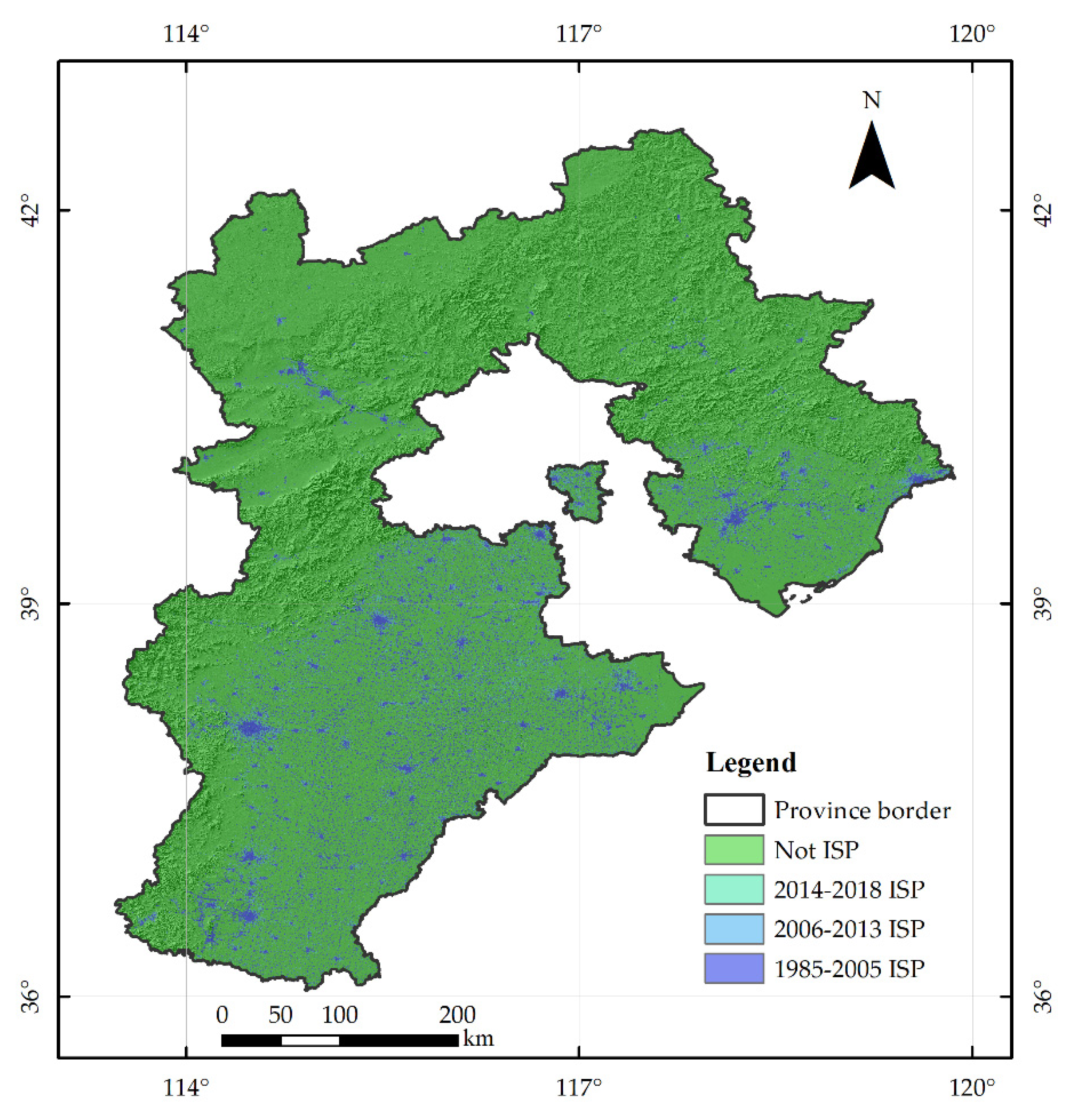
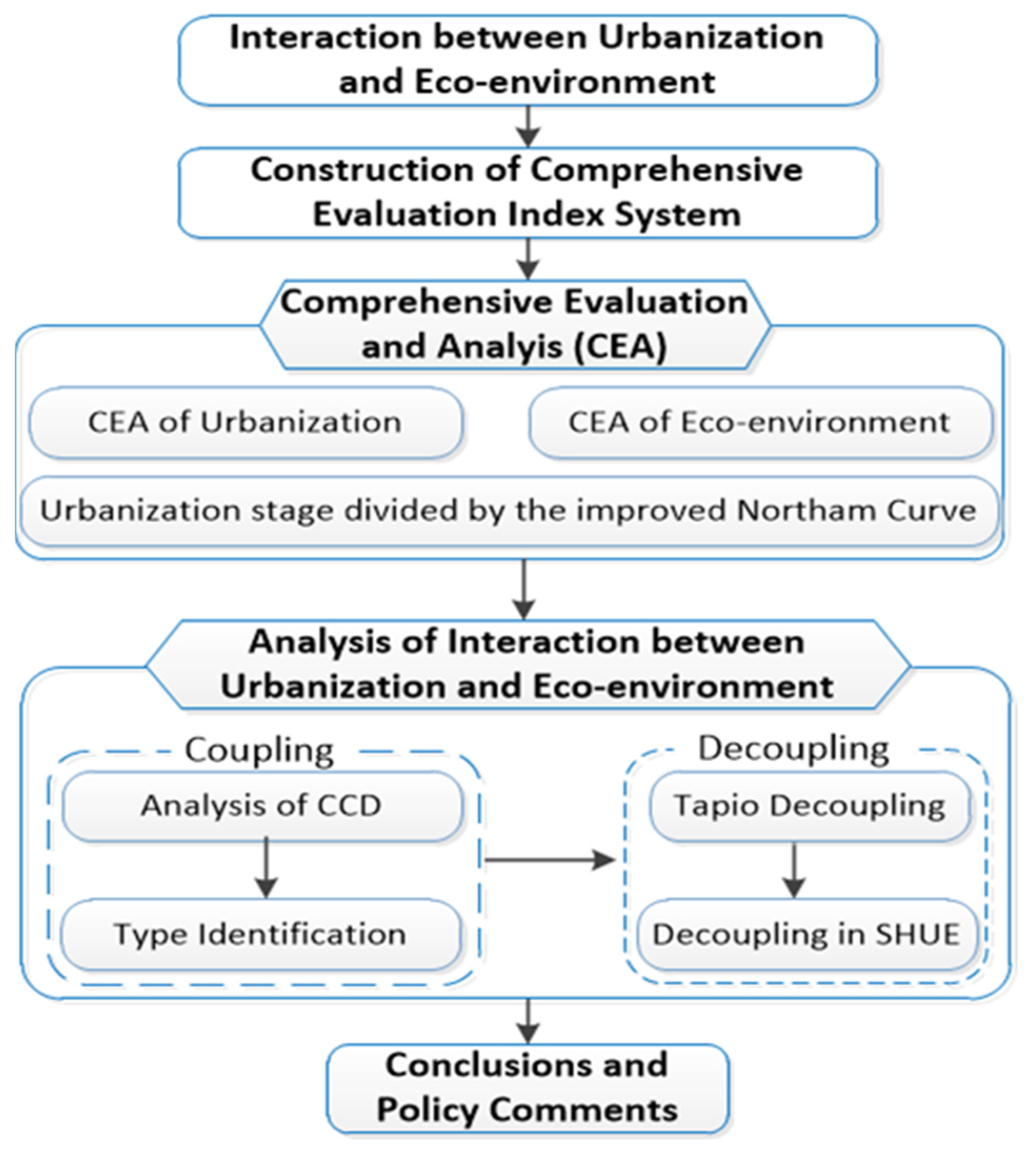
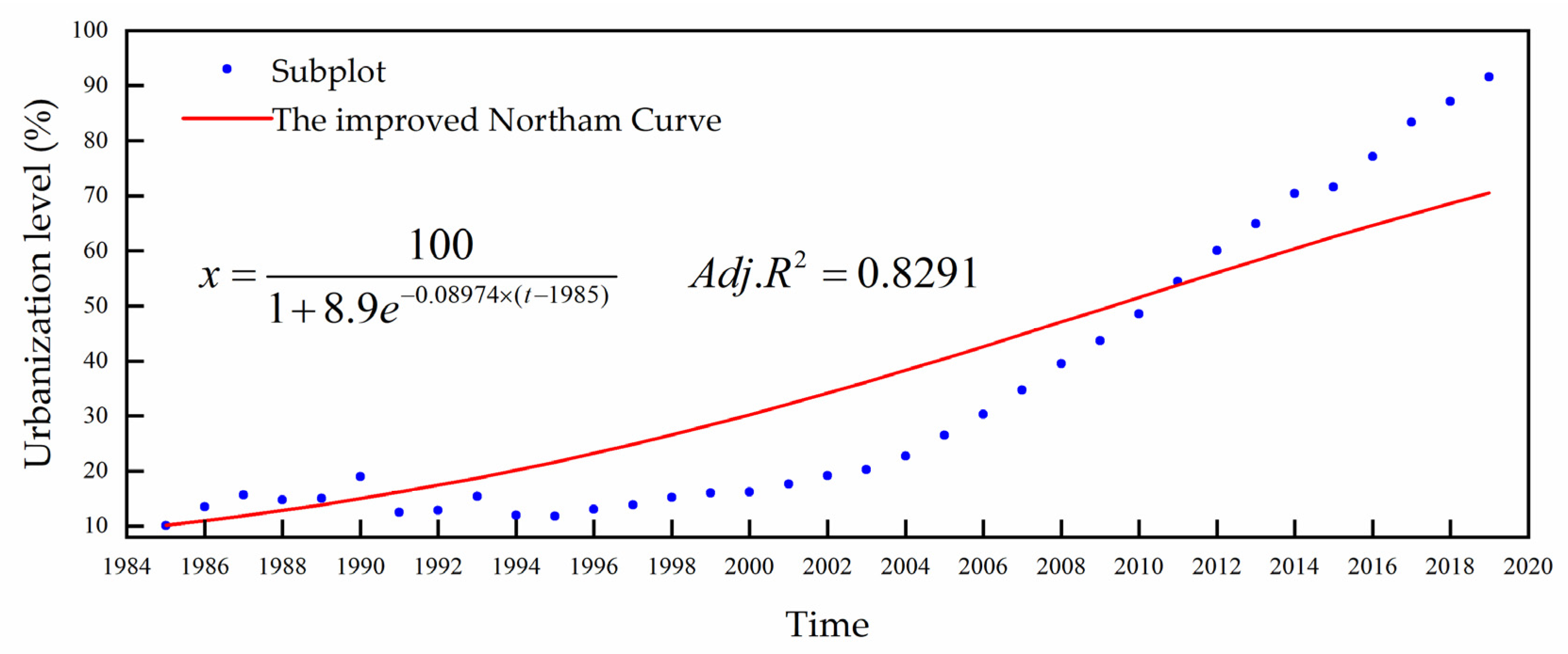
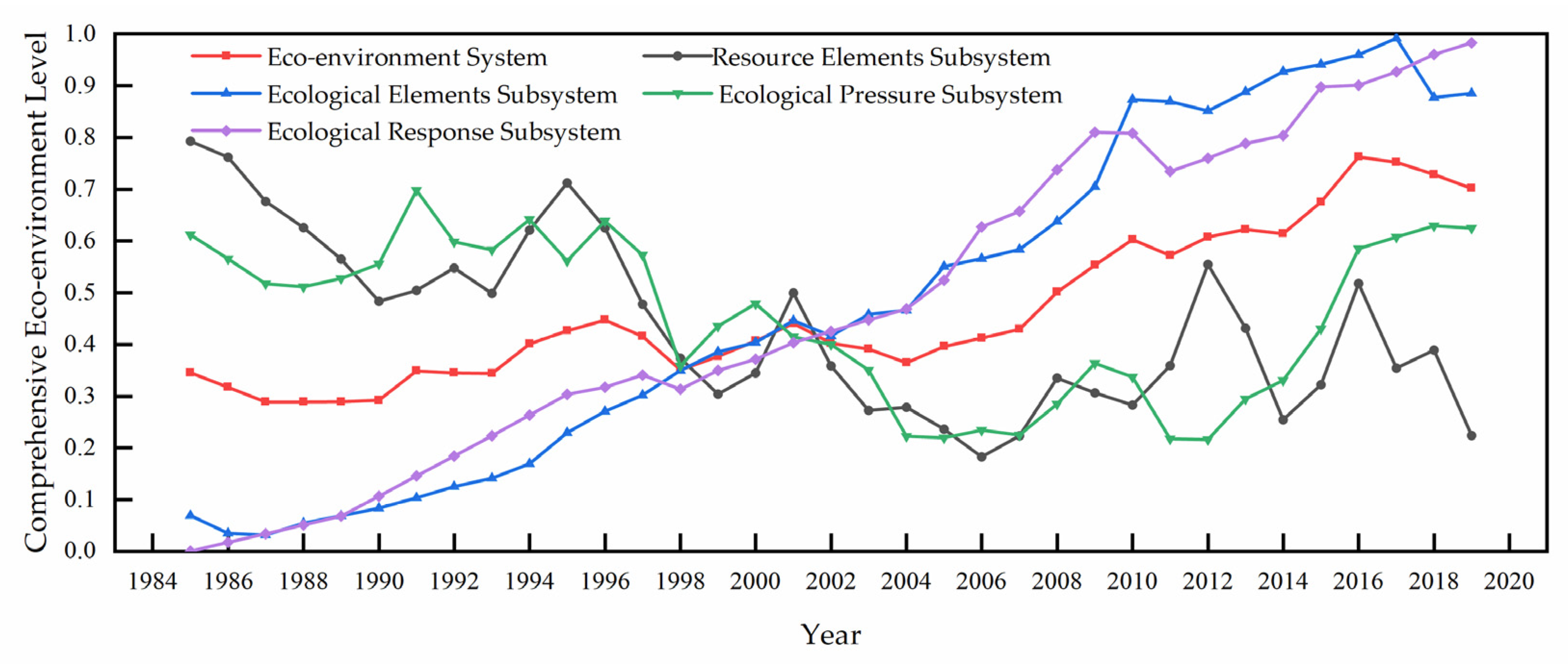
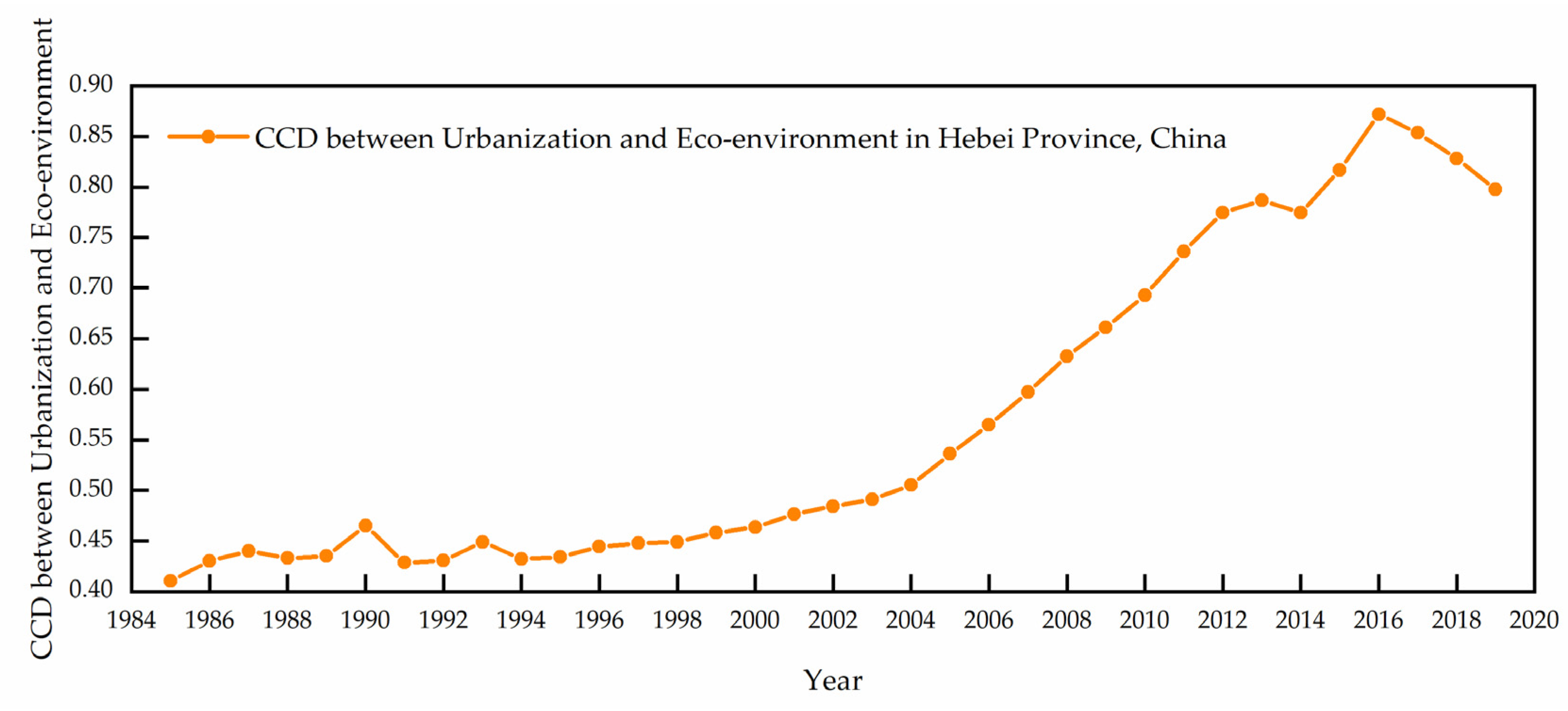
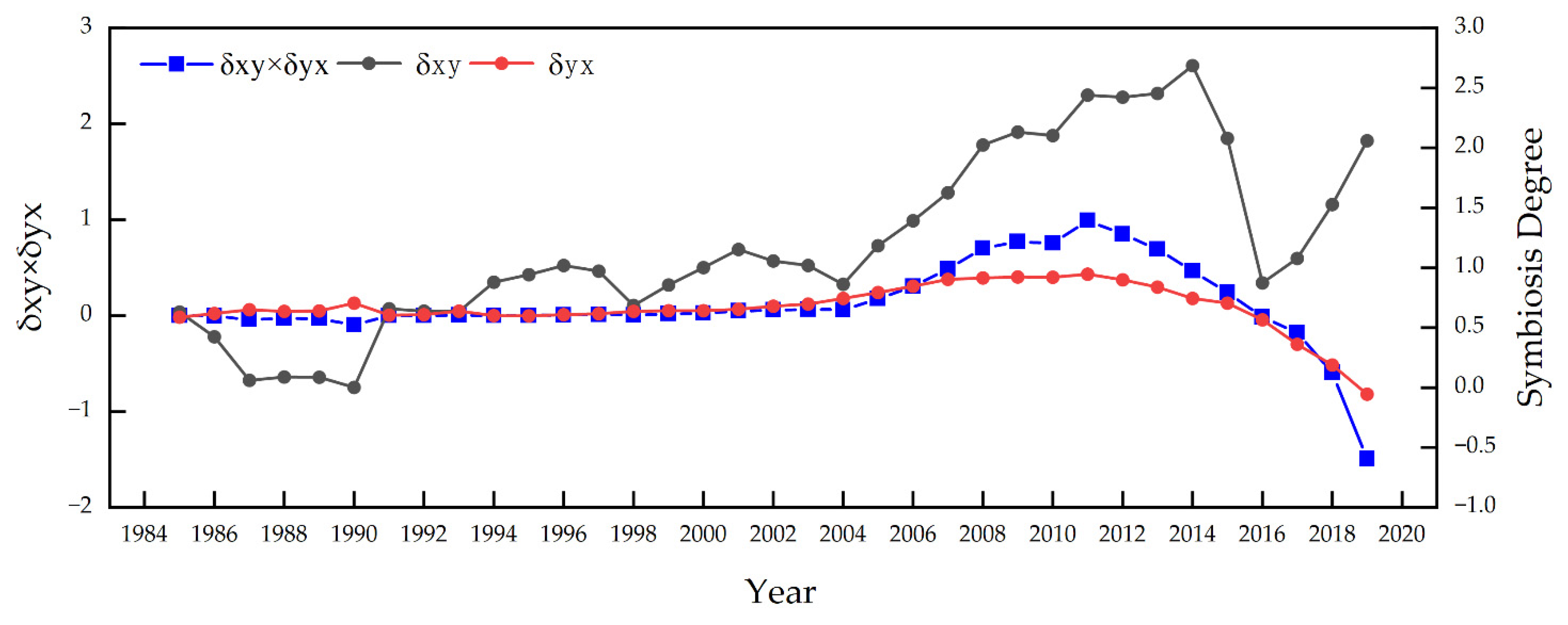
| System | First Grade Indicator | Weight Calculation | Basic Grade Indicator | Index Calculation | ||||
|---|---|---|---|---|---|---|---|---|
| EM | AHP | CW | EM | AHP | CW | |||
| Urbanization | Population | 0.162 | 0.123 | 0.142 | Urban Population Proportion | 0.376 | 0.552 | 0.463 |
| Natural Growth Rate of Population | 0.624 | 0.448 | 0.537 | |||||
| Economy | 0.397 | 0.388 | 0.394 | Gross Regional Product Per Capita | 0.305 | 0.470 | 0.419 | |
| The Proportion of Second and Third Industries in GDP | 0.070 | 0.280 | 0.154 | |||||
| The Proportion of Fiscal Revenue in Regional GDP | 0.162 | 0.114 | 0.150 | |||||
| The Total Investment in Fixed Assets of the whole Society | 0.463 | 0.136 | 0.277 | |||||
| Space | 0.059 | 0.101 | 0.077 | Urban Built-up Area Per Capita | 1 | 1 | 1 | |
| Society | 0.382 | 0.388 | 0.387 | Disposable Urban Income Per Capita | 0.298 | 0.550 | 0.418 | |
| Number of Hospital Beds Per 10,000 People | 0.341 | 0.210 | 0.277 | |||||
| Total Retail Sales of Consumer Goods | 0.361 | 0.240 | 0.305 | |||||
| Eco-environment | Resource Element | 0.220 | 0.170 | 0.198 | Total Available Water Resource Per Capita (+) | 0.381 | 0.550 | 0.484 |
| Arable Land Per Capita (+) | 0.223 | 0.330 | 0.286 | |||||
| Total Food Production Per Capita (+) | 0.396 | 0.120 | 0.230 | |||||
| Ecological Element | 0.276 | 0.460 | 0.365 | Green Coverage Rate of Built District (+) | 0.222 | 0.370 | 0.292 | |
| Green Area Per Capita (+) | 0.466 | 0.300 | 0.381 | |||||
| Percentage of Forest Cover (+) | 0.312 | 0.330 | 0.327 | |||||
| Ecological Pressure | 0.250 | 0.270 | 0.266 | Industrial Wastewater Discharge Per Capita (-) | 0.224 | 0.250 | 0.242 | |
| SO2 Emissions Per Capita (-) | 0.363 | 0.480 | 0.427 | |||||
| Industrial Waste Production Per Capita (-) | 0.205 | 0.070 | 0.123 | |||||
| ISP (-) | 0.208 | 0.200 | 0.208 | |||||
| Ecological Response | 0.254 | 0.110 | 0.171 | Comprehensive Utilization Rate of Industrial Solid Waste (+) | 0.192 | 0.360 | 0.272 | |
| Urban Sewage Treatment Rate (+) | 0.428 | 0.460 | 0.458 | |||||
| Hazard-free treatment ratio for home refuse (+) | 0.380 | 0.180 | 0.270 | |||||
| Category | CCD | Subcategory | Basic Category | |
|---|---|---|---|---|
| Coordinated Development | 0.60~1.00 | Coordinated Development (IV) | Eco-environment Lag Type (IV-1) | |
| Synchronization of Urbanization and Eco-environment Type (IV-2) | ||||
| Urbanization Lag Type (IV-3) | ||||
| Transition | 0.50~0.59 | Barely Coordinated Development (III) | Eco-environment Lag Type (III-1) | |
| Synchronization of Urbanization and Eco-environment Type (III-2) | ||||
| Urbanization Lag Type (III-3) | ||||
| 0.40~0.49 | Endangered Imbalance (II) | Eco-environment Lag Type (II-1) | ||
| Synchronization of Urbanization and Eco-environment Type (II-2) | ||||
| Urbanization Lag Type (II-3) | ||||
| Imbalance | 0.00~0.39 | Imbalance (I) | Eco-environment Lag Type (I-1) | |
| Co-dame of Urbanization and Eco-environment Type (I-2) | ||||
| Urbanization Lag Type (I-3) |
| Status | ||||
|---|---|---|---|---|
| Decoupling | Recession Decoupling | - | - | |
| Strong Decoupling | - | + | ||
| Weak Decoupling | + | + | ||
| Connection | Expansion Connection | + | + | |
| Recession Connection | - | - | ||
| Negative Decoupling | Negative Expansion Decoupling | + | + | |
| Negative Strong Decoupling | + | - | ||
| Negative Weak Decoupling | - | - | ||
| Symbiosis Mode | Interpretative Statement | |||
|---|---|---|---|---|
| Parasitic Symbiosis | - | + | <0 | Urbanization Promotes Eco-environment; Eco-environment Suppresses Urbanization. |
| + | - | <0 | Urbanization Suppresses Eco-environment, Eco-environment Promotes Urbanization. | |
| Partial Symbiosis | 0 | + | 0 | Urbanization Promotes Eco-environment; The Influence of Eco-environment on Urbanization is offset. |
| + | 0 | 0 | Eco-environment Promotes Urbanization; The influence of Urbanization on Eco-environment is offset | |
| Asymmetric Mutualism | + | >0 | Urbanization Promotes the other more than Eco-environment | |
| + | >0 | Eco-environment Promotes the other more than Urbanization | ||
| Symmetric Mutualism | + | >0 | Urbanization and Eco-environment Promote Each Other in The Same Degree |
| Year | 1985 | 1986 | 1987 | 1988 | 1989 | 1990 | 1991 | 1992 |
|---|---|---|---|---|---|---|---|---|
| CCR | (II-3) | (II-3) | (II-3) | (II-3) | (II-3) | (II-3) | (II-3) | (II-3) |
| Year | 1993 | 1994 | 1995 | 1996 | 1997 | 1998 | 1999 | 2000 |
| CCR | (II-3) | (II-3) | (II-3) | (II-3) | (II-3) | (II-3) | (II-3) | (II-3) |
| Year | 2001 | 2002 | 2003 | 2004 | 2005 | 2006 | 2007 | 2008 |
| CCR | (II-3) | (II-3) | (II-3) | (III-3) | (III-3) | (III-3) | (III-2) | (IV-3) |
| Year | 2009 | 2010 | 2011 | 2012 | 2013 | 2014 | 2015 | 2016 |
| CCR | (IV-3) | (IV-3) | (IV-2) | (IV-2) | (IV-2) | (IV-2) | (IV-2) | (IV-2) |
| Year | 2017 | 2018 | 2019 | |||||
| CCR | (IV-2) | (IV-1) | (IV-1) |
| Year | Status | Year | Status | ||||||
|---|---|---|---|---|---|---|---|---|---|
| 1986 | −0.0815 | 0.3394 | −0.2403 | Strong Decoupling | 2003 | −0.0280 | 0.0586 | −0.4770 | Strong Decoupling |
| 1987 | −0.0891 | 0.1589 | −0.5608 | Strong Decoupling | 2004 | −0.0679 | 0.1178 | −0.5764 | Strong Decoupling |
| 1988 | −0.0008 | −0.0582 | 0.0140 | Negative Weak Decoupling | 2005 | 0.0859 | 0.1678 | 0.5117 | Weak Decoupling |
| 1989 | 0.0016 | 0.0177 | 0.0930 | Weak Decoupling | 2006 | 0.0414 | 0.1437 | 0.2883 | Weak Decoupling |
| 1990 | 0.0109 | 0.2635 | 0.0414 | Weak Decoupling | 2007 | 0.0416 | 0.1456 | 0.2859 | Weak Decoupling |
| 1991 | 0.1927 | −0.3433 | −0.5614 | Negative Strong Decoupling | 2008 | 0.1670 | 0.1365 | 1.2229 | Negative Expansion Decoupling |
| 1992 | −0.0103 | 0.0281 | −0.3678 | Strong Decoupling | 2009 | 0.1042 | 0.1061 | 0.9825 | Expansion Connection |
| 1993 | −0.0037 | 0.1991 | −0.0186 | Strong Decoupling | 2010 | 0.0893 | 0.1115 | 0.8008 | Expansion Connection |
| 1994 | 0.1658 | −0.2238 | −0.7409 | Negative Strong Decoupling | 2011 | −0.0513 | 0.1205 | −0.4253 | Strong Decoupling |
| 1995 | 0.0637 | −0.0111 | −5.7199 | Negative Strong Decoupling | 2012 | 0.0634 | 0.1046 | 0.6061 | Weak Decoupling |
| 1996 | 0.0482 | 0.1049 | 0.4600 | Weak Decoupling | 2013 | 0.0243 | 0.0812 | 0.2988 | Weak Decoupling |
| 1997 | −0.0695 | 0.0631 | −1.1015 | Strong Decoupling | 2014 | −0.0139 | 0.0838 | −0.1659 | Strong Decoupling |
| 1998 | −0.1567 | 0.0981 | −1.5976 | Strong Decoupling | 2015 | 0.0997 | 0.0176 | 5.6705 | Negative Expansion Decoupling |
| 1999 | 0.0743 | 0.0502 | 1.4798 | Negative Expansion Decoupling | 2016 | 0.1290 | 0.0762 | 1.6922 | Negative Expansion Decoupling |
| 2000 | 0.0794 | 0.0130 | 6.1133 | Negative Expansion Decoupling | 2017 | −0.0133 | 0.0809 | −0.1642 | Strong Decoupling |
| 2001 | 0.0845 | 0.0898 | 0.9404 | Expansion Connection | 2018 | −0.0312 | 0.0462 | −0.6759 | Strong Decoupling |
| 2002 | −0.0876 | 0.0877 | −0.9988 | Strong Decoupling | 2019 | −0.0372 | 0.0500 | −0.7443 | Strong Decoupling |
| Year | Symbiosis Mode | Year | Symbiosis Mode | ||||||
|---|---|---|---|---|---|---|---|---|---|
| 1985 | 0.0384 | −0.0171 | −0.0007 | Parasitic | 2003 | 0.5245 | 0.1212 | 0.0636 | Asymmetric Mutualism |
| 1986 | −0.2195 | 0.0217 | −0.0048 | Parasitic | 2004 | 0.3271 | 0.1786 | 0.0584 | Asymmetric Mutualism |
| 1987 | −0.6745 | 0.0617 | −0.0416 | Parasitic | 2005 | 0.7295 | 0.2411 | 0.1759 | Asymmetric Mutualism |
| 1988 | −0.6391 | 0.0448 | −0.0286 | Parasitic | 2006 | 0.9893 | 0.3079 | 0.3046 | Asymmetric Mutualism |
| 1989 | −0.6426 | 0.0495 | −0.0318 | Parasitic | 2007 | 1.2812 | 0.3789 | 0.4855 | Asymmetric Mutualism |
| 1990 | −0.7477 | 0.1307 | −0.0977 | Parasitic | 2008 | 1.7808 | 0.3941 | 0.7018 | Asymmetric Mutualism |
| 1991 | 0.0723 | 0.0066 | 0.0005 | Asymmetric Mutualism | 2009 | 1.9152 | 0.4022 | 0.7702 | Asymmetric Mutualism |
| 1992 | 0.0465 | 0.0109 | 0.0005 | Asymmetric Mutualism | 2010 | 1.8774 | 0.4014 | 0.7536 | Asymmetric Mutualism |
| 1993 | 0.0437 | 0.0470 | 0.0020 | Asymmetric Mutualism | 2011 | 2.3015 | 0.4316 | 0.9933 | Asymmetric Mutualism |
| 1994 | 0.3481 | 0.0004 | 0.0001 | Asymmetric Mutualism | 2012 | 2.2784 | 0.3730 | 0.8498 | Asymmetric Mutualism |
| 1995 | 0.4270 | −0.0008 | −0.0003 | Parasitic | 2013 | 2.3172 | 0.2986 | 0.6920 | Asymmetric Mutualism |
| 1996 | 0.5240 | 0.0105 | 0.0055 | Asymmetric Mutualism | 2014 | 2.6065 | 0.1795 | 0.4678 | Asymmetric Mutualism |
| 1997 | 0.4656 | 0.0203 | 0.0094 | Asymmetric Mutualism | 2015 | 1.8489 | 0.1304 | 0.2411 | Asymmetric Mutualism |
| 1998 | 0.1058 | 0.0437 | 0.0046 | Asymmetric Mutualism | 2016 | 0.3405 | −0.0443 | −0.0151 | Parasitic |
| 1999 | 0.3208 | 0.0518 | 0.0166 | Asymmetric Mutualism | 2017 | 0.5977 | −0.2998 | −0.1792 | Parasitic |
| 2000 | 0.5018 | 0.0509 | 0.0256 | Asymmetric Mutualism | 2018 | 1.1601 | −0.5142 | −0.5966 | Parasitic |
| 2001 | 0.6913 | 0.0668 | 0.0462 | Asymmetric Mutualism | 2019 | 1.8232 | −0.8194 | −1.4940 | Parasitic |
| 2002 | 0.5693 | 0.0984 | 0.0560 | Asymmetric Mutualism |
Publisher’s Note: MDPI stays neutral with regard to jurisdictional claims in published maps and institutional affiliations. |
© 2022 by the authors. Licensee MDPI, Basel, Switzerland. This article is an open access article distributed under the terms and conditions of the Creative Commons Attribution (CC BY) license (https://creativecommons.org/licenses/by/4.0/).
Share and Cite
Wang, H.; Zhao, A.; Cao, Y.; Xie, Y.; Guo, L. Interaction between Urbanization and Eco-Environment in Hebei Province, China. Sustainability 2022, 14, 9214. https://doi.org/10.3390/su14159214
Wang H, Zhao A, Cao Y, Xie Y, Guo L. Interaction between Urbanization and Eco-Environment in Hebei Province, China. Sustainability. 2022; 14(15):9214. https://doi.org/10.3390/su14159214
Chicago/Turabian StyleWang, Hefeng, Ao Zhao, Yuan Cao, Yi Xie, and Lanxuan Guo. 2022. "Interaction between Urbanization and Eco-Environment in Hebei Province, China" Sustainability 14, no. 15: 9214. https://doi.org/10.3390/su14159214
APA StyleWang, H., Zhao, A., Cao, Y., Xie, Y., & Guo, L. (2022). Interaction between Urbanization and Eco-Environment in Hebei Province, China. Sustainability, 14(15), 9214. https://doi.org/10.3390/su14159214






